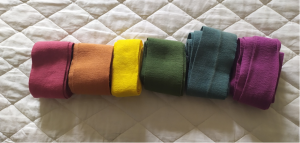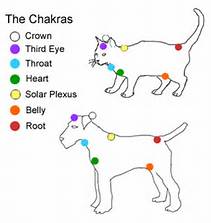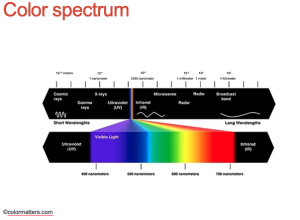
Thanks to my friend and TTouch colleague in Switzerland, Lisa Leicht, I am the proud owner of a set of TTouch wraps dyed to the colours of the six major chakras: red, orange, yellow, green, blue and magenta.
Over the past few weeks, I have been doing an experiment with Salma using the coloured TTouch wraps. Every night I have wrapped her with one colour. The same colour was used for 7 days.
Chakra es a hindu word meaning “wheels of light” and represents subtle energy within the body’s aura or subtle energetic body.
As most people know, each chakra has an affinity with a particular area of action, and influences the hormone producing glands of the endocrine system.
- Red corresponds to the Root Chakra or Muladhara. It is grounding and acts like first aid. Its action is mainly physical and the effect is similar to walking barefoot on the grass or on the beach.
- Orange is the colour of the Sacral Chakra or Svadisthana. Orange is the colour of creativity and is related to the sexual organs. It is vitalising and can promote a sense of joie de vivre so, when an animal is low in spirit or depressed, orange may the colour it needs most. It is also known as having the “arnica effect”. In homoeopathy when there is shock or trauma, arnica is often administered and prevents bruising whether from physical or emotional wounds.
- Yellow is related to the solar plexus or Manipura We often say that something has hit us “in the gut”, right there in the solar plexus, and often the consequences are stomach upsets due to emotional stress. Yellow is invigorating and helps with mental stimulation.
- Green is the colour of the heart Chakra or Anahata. Green, the colour of nature, has been shown to bring calm to even the most disturbed souls when people walk, particularly barefoot, in green spaces or in the forest. The Japanese have a technique called Shinrin Yoku or Forest Bathing designed to do just that. In many cultures and languages there are expressions where green is the colour of hope so, once again, when spirits are low or disturbed, green is a useful colour.
- Blue is related to the throat Chakra or Visuddha, and is connected to communication. As we know from zoopharmacognosy, two of the essential oils that we use, German Chamomile and Yarrow, are blue in colour due to the presence of chamazulene. Both oils are used where there is inflammation, heat and redness. Blue is definitely a cooling, calming colour, so animals who are over-excited and perhaps bark too much for their guardian’s liking might benefit from a blue wrap.
- Violeta is linked to the Crown Chakra or Sahasrara. This is the higher space of super-personal or unconditional love. It is also linked to the Triple Heater Meridian in Traditional Chinese medicine, strengthening and balancing the whole system.
| Name & location | Element | Colour | Emotion |
Endocrine gland |
Psychological Function | Area covered |
| Sahasrara/Crown | Thought | Violet | Bliss | Pituitary | Understanding Enlightenment | Upper brain/ right eye |
| Ajna/ Brow | Light | Indigo | Dreaming | Pineal | Intuition
Wisdom |
Lower brain/ left eye/ ears/nose
|
| Vishuddha/Throat | Sound/Ether | Blue | Connection | Thyroid
Parathyroid |
Will power
Communication |
Vocal & bronchial tubes, lungs, alimentary canal |
| Anahata/Heart | Air | Green | Compassion | Thymus | Love
Harmony |
Heart/Blood/
Circulation |
| Manipura /Solar plexus | Fire | Yellow | Laughter/Joy/Anger | Pancreas | Personal power/Self worth | Stomach/Liver/
Gall bladder |
| Svadhisthana/Sacral | Water | Orange | Tears | Gonads | Desire/Sexuality |
Sacrum |
| Muladhara/Base, perineum & Coccygeal | Earth | Red | Stillness | Adrenals | Survival | Kidneys/Spinal column |

Some may point out that dogs do not see the red/green spectrum of colour and, of course, they are right. Dogs do not see these colours, but there is more to colour than the visual aspect. Each colour has a vibrational frequency which the body can perceive, and even beyond the visible spectrum of light there are other frequencies which we perceive without even knowing it.

An interesting experiment was done by doctors in Cuba with the participation of a number blind people. One room was painted red and another blue. The participants were asked to sit first in one room and then the other. The fascinating outcome was that while they were in the red room, the participants began to feel hot, whereas in the blue room they began to feel cold!
What implications does this have for us working with our animal? It means that —happily —although dogs do not see red and green, they can definitely perceive the vibrations of that colour and so the beneficial effects of the various coloured wraps will be felt.
The fact that the wraps are touching various parts of the body and the contact areas vary with movement means that this sense of touch sets in motion a whole host of chemical messages throughout the nervous system as it relays messages from and to the brain via the nerves and spine, stimulating the circulation of blood and the hormones carried with it.
At the subtle energetic level, this contact also influences the chakras and therefore the endocrine system, helping to release blockages and balance deficiencies within the meridian system of which the chakras and the entry and exit points in terms of energy distribution.
My main objective for Salma with this experiment was to help boost her self-confidence. She is a pretty grounded and happy dog but, as I have mentioned in some previous posts, since her disagreeable encounter with a neighbour’s dog, she is wary of other dogs approaching or barking at her.
Over the last few weeks, I have been able to observe that she is less likely to be affected when dogs bark at her, and she has been better able to negotiate situations where dogs have come up to her on walks. Another area where she is showing progress is with the cats. When she first arrived, we had two very gentle cats but they are now no longer here. The remaining house cat is unpredictable and very vocal, which makes for insecure relationships. She is now managing to negotiate the cat in terms of space and movement, which is a great step forward. Of course, both these improvements are encouraged using positive reinforcement with the clicker. She still has a way to go, but I think we are on the right track!
I am letting her rest for a few days, and perhaps in a week or so I will repeat the sequence with the orange, yellow and green wraps.
©Mary J Rodriguez
